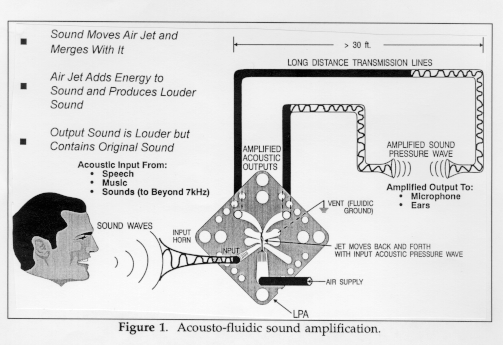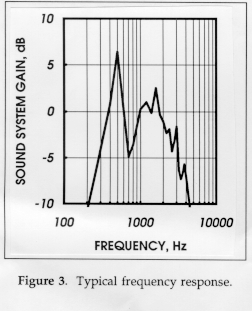Tadeusz M. Drzewiecki - 73172.642@compuserve.com
Defense Research Technologies, Inc.
354 Hungerford Dr.
Rockville, MD 20850
Popular version of paper 2aAA8
Presented Tuesday morning, December 3, 1996
Third Joint ASA/ASJ Meeting, Honolulu, Hawaii
Embargoed until December 3, 1996
This paper reports the development of a non-electrical sound augmentation system that uses acousto-fluidic technology to amplify and transmit voice sounds. Because of the unique religious restrictions of Orthodox Judaism, use of electronic sound reproduction per se to amplify and transmit the voice of a rabbi or cantor is not allowed because it contravenes the prohibition of performing labor on the Sabbath or on holy days. Labor is defined in the Halacha (Jewish Law) as the creation of anything new. Since conventional sound transduction or reproduction involves the creation of several new things or states, that is, the speaker's sound causes a diaphragm to move that was previously at rest (a new state), the diaphragm motion creates an electrical current that did not exist before, the electrical current causes another diaphragm to move, and the diaphragm motion creates a new sound that also did not exist before (albeit sounding the same, it is nonetheless not the same sound), therefore, its use is not kosher and is thus prohibited. Sound augmentation, however, that is the restoration of the original sound to its original level, all the while preserving the actual sound, is permissible as long as no apparent sound level amplification is evident.
Acousto-fluidics is the technology by which sound can be amplified by using the mechanical gain obtained from the deflection of a high energy jet of air. Figure 1 shows how an acousto-fluidic sound amplifier works. Sound pressure interacts with an air jet and causes it to deflect into a channel which causes the pressure in the channel to rise in proportion to the lateral deflection and the kinetic energy in the jet. Since the recovered pressure is much larger than the sound pressure that caused the deflection this phenomenon is called pressure or acoustic gain. One can visualize this process by thinking of what happens when one speaks near a candle flame which flickers (deflects) at the same frequency as the sound. The sound that deflects the air jet coalesces with the air stream and is carried along, just the same way sound is picked up by the wind. It is this analogy that has been used by the rabbis when they have dubbed our system the "wind microphone". By successively amplifying the sound with additional serial amplifiers, virtually any amount of level or power amplification is possible.
 Figure 1. Acousto-fluidic sound amplification
Figure 1. Acousto-fluidic sound amplification
Thus, when sound is introduced into a tube or pipe and is attenuated as it transmits down the pipe, we are able to amplify the sound to a level above that which entered the pipe. The amplified sound is then transmitted along another pipe, attenuated and caused to emanate from a horn as far as 30 meters away from the speaker's location at the same level as it entered originally.
Since sound attenuates very quickly once it leaves the mouth, the sound level at the back of even acoustically well-designed large synagogues can be very low and more often than not is further masked by surrounding voices, rustling and the motion of congregants. On holy days, a particularly difficult situation occurs because of the large number of people who attend services. In order to accommodate overflow crowds, additional rooms are opened up. Figure 2 shows a typical arrangement of a sanctuary and a social hall in the back that can be opened up to accommodate additional people. Also shown is the arrangement of our kosher sound system. These additional rooms are generally not as well acoustically designed as a sanctuary, thus congregants seated there find it difficult to hear let alone understand the rabbi or the cantor. In the Hampton Synagogue, in Westhampton Beach, Long Island, where we made our first installation in 1994, overflow crowds were put out on outdoor patios on either side of the sanctuary, each accommodating over 300 congregants. There the open-air acoustics or tent-covered acoustics were even worse, as there was virtually no enhancement available from room reverberation. (Inside buildings the reflections off the walls and ceilings allow for better acoustics.)
 Figure 2. Typical installation in a sanctuary opening to a social hall.
Figure 2. Typical installation in a sanctuary opening to a social hall.
Our current system takes the rabbi's input sound and transmits it directly through a 20-ft, 2-in diameter PVC pipe to several channels of four-stage acousto-fluidic amplifiers. The augmented sound is then transmitted through 50-ft long pipes to output horns (Electrovoice constant directivity horns) which expand the sound from the pipe without distorting it. We are able to provide sound levels comparable to those right near the mouth of the person speaking (about 90dB SPL). Since the mouth of the horns can be as wide as 1 meter, the acoustic fall off as a function of distance away from the horn is far less than from a human mouth, and as a result people as far as 100 ft away, even in open air, can clearly distinguish and understand the spoken or sung words.
The system with four to six channels (eight to twelve output horns) provides adequate sound coverage in worship spaces accommodating as many as 1600 persons. A kosher sound system has been built and tested. It provides essentially 0dB sound level gain and about 50dB of acoustic power gain. Air pressure is provided by a large aquarium pump capable of developing 10psi. The use of an electrically-powered air pump is per- missible as long as the system is turned on before the Sabbath and because the spoken sound does not affect or modulate the electricity operating the pump - thus no labor is performed. The frequency response of the entire system including 25 feet of input and 35 feet of output 2-inch diameter pipe, is shown in figure 3. The response is uniform to within a factor of two (plus or minus 6dB) from 250Hz to 3.5kHz. The low frequency cut off, which is determined by the output horn, is at about 200Hz, and the high frequency cut off is past 6kHz, which is determined by the amplifier dynamics.
 Figure 3. Typical frequency response.
Figure 3. Typical frequency response.
Since the acousto-fluidic amplifier is inherently a differential device, a single channel provides two 180-degree out-of-phase outputs. We have found that ElectroVoice HB640 horns do an excellent job of getting the sound out in a relatively small package. The monaural sound quality is good enough for easy recognition of the speaker's voice with good reproduction of enough overtones to render singing pleasant. Sounds can be transmitted up to 25m through 5cm-diameter PVC pipes thereby allowing speaker horns to be placed far enough away from the inputs to ensure good aural reception at the furthest reaches of worship spaces and in overflow rooms.
An interesting advantage of acoustic augmentation over electronic amplification is the fact that the entire process occurs at the speed of sound rather than at the speed of light. In our system the sound travels through the sound pipes at the same speed as the voice in air so that the sound coming out of a speaker arrives at the same time as the spoken voice or the outputs of nearer horns and, as a result, there is no bothersome echoing. Using an electronic system one has to specially design in time delays to prevent echoing. Consequently the acousto-fluidic system provides a very natural sound and rendition.